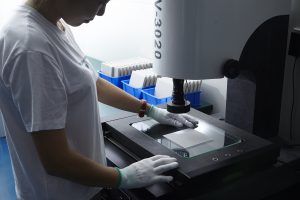Aluminum nitride (AlN) is a ceramic material with exceptional properties, composed of aluminum and nitrogen. In recent years, with advancements in technology, AlN has shown tremendous potential in various fields, particularly in electronics, energy, and aerospace industries. This article introduces the basic properties, synthesis methods, and advantages of aluminum nitride, along with its promising applications.
1. Basic Properties of Aluminum Nitride
High Thermal Conductivity:One of AlN’s most notable features is its outstanding thermal conductivity. Compared to traditional ceramic materials, AlN exhibits a much higher thermal conductivity, typically ranging from 180 to 200 W/m·K. This superior heat transfer capability makes it invaluable in applications like electronic component cooling and thermal management systems.
Electrical Insulation:Despite its high thermal conductivity, AlN possesses excellent electrical insulation properties, meaning it does not conduct electricity. This makes it ideal for high-power electronic devices requiring both thermal management and electrical isolation.
Chemical Stability and Corrosion Resistance:AlN is chemically stable and resistant to corrosion, even in high-temperature and humid environments. It also withstands many acidic and alkaline solutions, enabling it to operate reliably in harsh conditions.
Mechanical Properties:AlN exhibits relatively high hardness and good compressive strength, though it is somewhat brittle. As a result, care must be taken to avoid excessive mechanical impacts during its use.
Low Thermal Expansion Coefficient:With a low coefficient of thermal expansion, AlN is compatible with some metal materials, reducing deformation caused by temperature fluctuations. This makes it ideal for precision applications such as electronic packaging.
2. Synthesis Methods of Aluminum Nitride
The synthesis of AlN typically involves two main methods: gas-phase synthesis and solid-phase synthesis.
Gas-Phase Synthesis:Gas-phase synthesis is often used to produce high-purity AlN. It involves the reaction of aluminum with nitrogen gas at high temperatures, usually between 1000°C and 1500°C. This method ensures precise control over the quality of AlN and yields a highly pure product.
Solid-Phase Synthesis:In solid-phase synthesis, aluminum powder reacts with nitrogen compounds (e.g., ammonia gas) at high temperatures to form AlN. This approach is relatively simple and suitable for large-scale production.
3. Applications of Aluminum Nitride
Electronics Industry:AlN is increasingly used in the electronics industry, particularly in high-power electronic device thermal management. Its high thermal conductivity and electrical insulation make it ideal for LED heat dissipation substrates, power module substrates, and laser diode substrates.
Thermal Management Systems:Thermal management is critical in modern electronic products. AlN’s excellent thermal conductivity makes it widely applied in thermal conduction and dissipation systems for high-frequency radar, aerospace electronics, communication devices, and more.
Lasers and Optoelectronic Devices:Due to its superior thermal and electrical properties, AlN is used as a thermal interface material in lasers and optoelectronic devices. It is especially effective in high-power lasers and optical sensors, reducing operating temperatures and extending device lifespans.
Aerospace and High-Temperature Environments:The chemical stability of AlN enables it to perform well in high-temperature, low-oxygen, or vacuum environments. As a result, it finds applications in spacecraft, rocket engines, and similar fields.
New Energy Technologies:In electric vehicles and other renewable energy technologies, AlN is used in high-power electronic devices, particularly in battery management systems, as a thermal interface material to improve thermal management efficiency.
4. Future Development of Aluminum Nitride
As technology advances, the range of AlN applications continues to expand. In the future, AlN is expected to play a larger role in quantum computing, ultra-high-frequency electronic devices, and other cutting-edge technologies. Additionally, the decreasing production costs of AlN are likely to drive its adoption in even more fields.
In summary, aluminum nitride, as a high-performance ceramic material, holds a unique position in various industries due to its exceptional thermal and electrical properties. With continuous technological progress, the application prospects of AlN are vast, offering superior material solutions for many high-tech products in the years to come.





